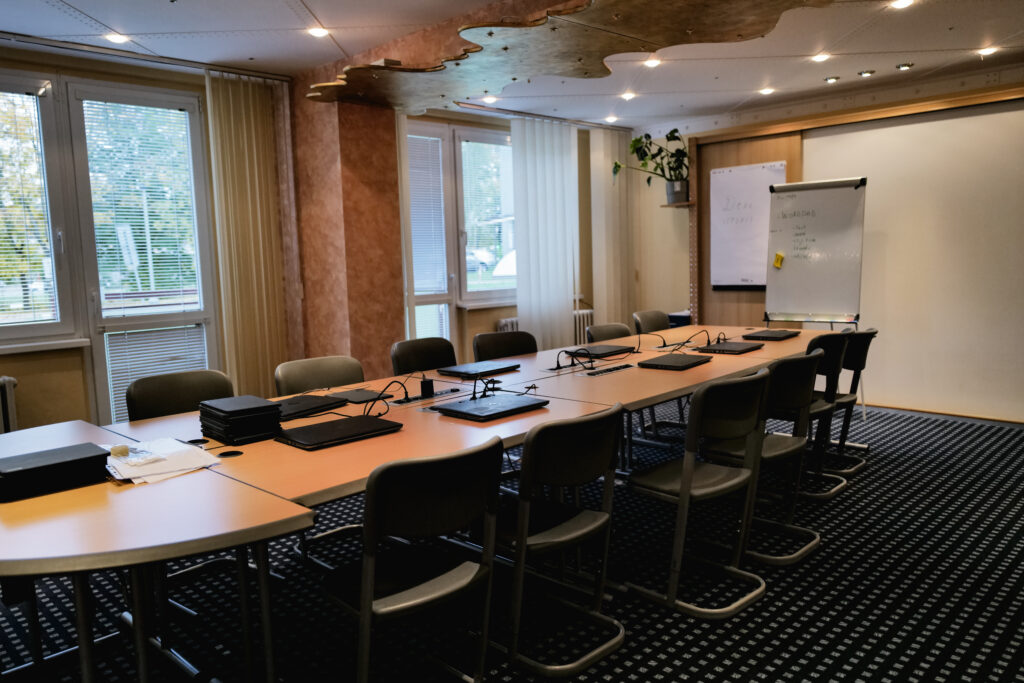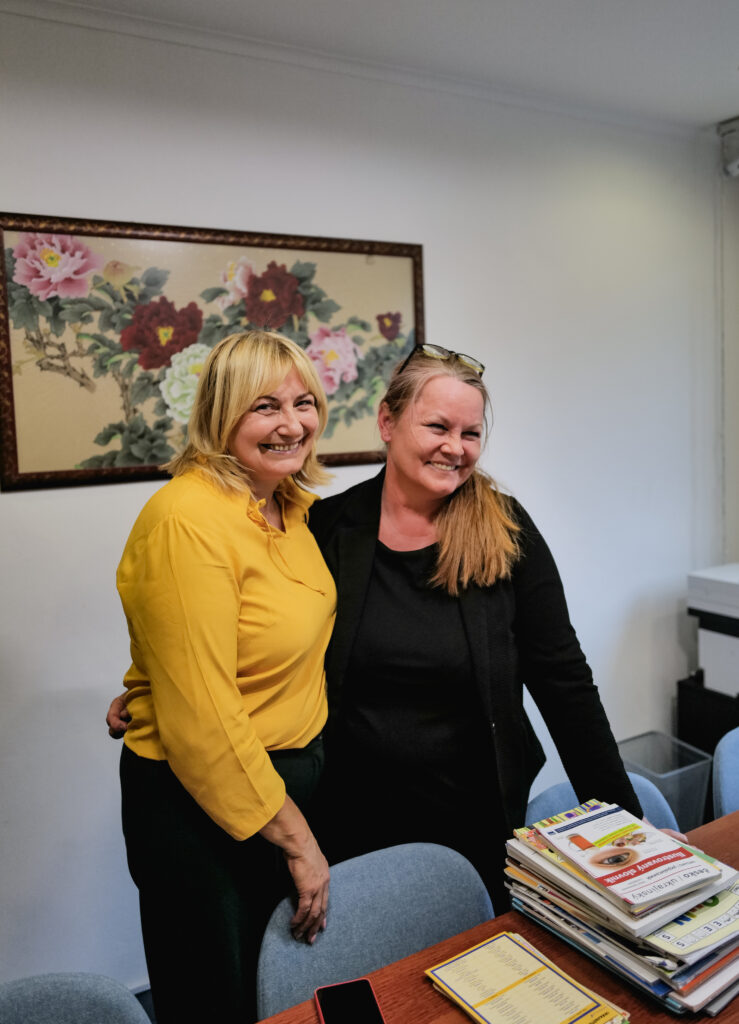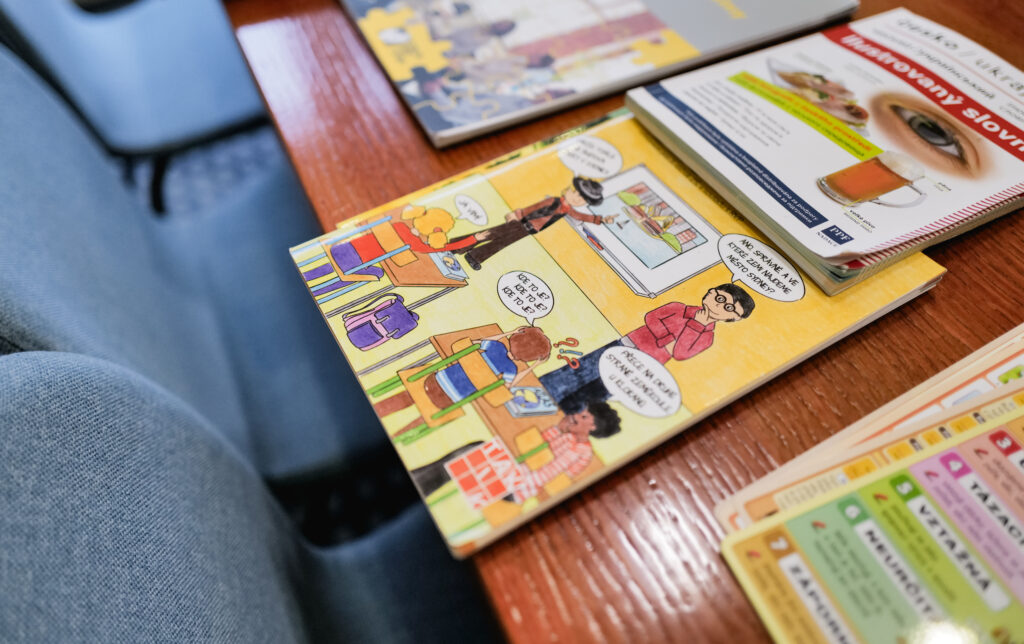The Children of Ukraine organization helps Ukrainian children who ended up in the Czech Republic as a result of the war. The school of this organization is an ideal place for children whose parents do not know when they will return to Ukraine. It respects the Ukrainian education system so children can continue their education smoothly after returning to their homeland. But they are also learning the Czech language. Mrs. Oksana has been in Prague for over 27 years. She is breathing for the organization. She is also investing her own finances and all her free time in the school.
You are not a teacher yourself. So how did the idea of a Ukrainian school arise?
Especially at the beginning of the war, there was a need for help. My family and I thought about how we could get involved. I like children, so we created children’s playrooms. We started in the library and wondered what to do next. We wanted to find a bigger space where children from Ukraine would be together. The main idea was to get them out of the home environment so they wouldn’t have to listen to mommy crying all day.
Did you move here from the library – to Praha 4?
Not immediately. At the beginning, up to 280 children visited us. We had four rented spaces in different parts of Prague. St. Augustine’s schools and New PORG have been helping us since the very beginning. The church even rented premises to us on Křižíková Street. And now we are here – in Prague 4, in office space. Last year we used it for free thanks to our sponsors, now we have to pay.
Your school currently takes care of more than a hundred children.
Yes, 89 children go to school and 28 to kindergarten. They are the children who did not get into Czech schools. The second condition for admission to us is a confirmed refugee status. At school, we teach according to the Ukrainian curriculum. There are children who officially attend a Ukrainian school and participate in classes online. So that they don’t have to be at home alone without their mother, who is at work, they are here, and we help them. They receive an assessment from us, based on which the Ukrainian school then issues them a report card. But our capacity is limited due to space – a maximum of 12 children can fit into one class.

How do you find funding to run the school?
The People in Need organization helps us a lot. We have already received over a million crowns from them. It was actually one of the first sponsors who contacted us. At the moment, we get funding mainly thanks to grants. For example, we won a grant from the City Hall of Prague for teaching the Czech language for four months. But there are not many sponsors anymore, although we still need help.
Do you want to help Children of Ukraine? You can send a financial contribution via QR code (transparent account: 6203118399/0800). If you want to offer material help, contact Mrs. Oksana directly. Currently, the organization mainly needs computers and other technology.
Did you find teachers easily?
Yes, finding teachers was not a problem at all. For example, I needed a Czech and English teacher, and 50 candidates applied overnight. We currently have 22 teachers here. The children have very high-quality education. They are also taught by a professor from the university. Not even in Ukraine does anyone get access to such capacities.
You would like to open an accredited Czech-Ukrainian school.
I dream of such a school. We are working on it; I have already spoken with the Ministry of Education. I will definitely apply, but unfortunately, they won’t be able to approve it until next year.
Do you reminisce about home – Ukraine with the children?
No one is sure how long the children will stay here or if they will return home. Therefore, we try to keep Ukrainian traditions and customs alive. We want Ukrainian culture not to die out among them, so that they know where they come from. We were recently visited by Ukrainian football players who defeated Macedonia in Prague. They chatted with children and their parents. In addition to Ukrainian culture, we also introduce children to Czech culture. November 11 is war veterans’ day, and we will go to Kořenov. Last year, we planted an avenue of gratitude to the Czech nation there with the children. Each tree has its own tag with its name, the name of the child from Kořenov who is supposed to take care of it, and the region of Ukraine where the child who planted the tree is from. So, we’ll go see how the trees are doing. We also celebrate “dušičky.” Last year we celebrated Saint Nicholas. There is so much more, we are always doing something with the kids.
And you also talk about the war with them.
We still remember it. The soldiers who are now fighting there visited us several times. Children need to know what is happening at home and learn how to deal with the situation. Especially the elderly suffer a lot. They left their friends and fathers there. But we have a school psychologist who they can turn to at any time.
Two Czech language teachers work in the Children of Ukraine organization. One of them, Mrs. Monika Špirková, introduced us to what such teaching looks like.
How often do children have Czech lessons?
Children learn Czech three times a week. In the afternoon, preparation for entrance exams to Czech schools for older students takes place – they discuss the basics of mathematics, physics and chemistry in the Czech language.

You previously worked in Czech schools as a teacher of Czech and English. How did you manage to set up classes for Ukrainian children?
In the beginning, it was one big experiment. The classic Czech language textbooks turned out to be dysfunctional. In the classroom, we have very heterogeneous groups of children who have very different knowledge. Some are in the Czech Republic for a month, some for a year. One has completed Czech language courses, the other is starting from scratch. The lessons are very demanding to prepare, and it is difficult to find a uniform procedure. You have to figure out how to work with one material on different levels.
“At first, the children were scared, sad, fearful and unable to concentrate. Now they have become accustomed to the situation – they are integrated, happy and relaxed. I was very moved by one homework assignment where the children had to write how they like Prague. The comments were generally positive and full of gratitude.”
– Monika Špirková
Which materials do you use when classic textbooks didn’t work?
I try to cover the subjects that the students should be able to master according to their age in case they start a Czech school. I use materials from various sources for this. I use textbooks that are intended for accelerated teaching of foreigners. I can mention, for example, Domino, Česky krok za krokem, Česky raz dva, Hezky česky, Česky levou zadní nebo Česky, prosím Start. I also work a lot with materials available on the Internet. The company META operates the inkluzivniskola.cz portal, where you can find a lot of documents for download. They also organize workshops that I attend. The umimecesky.cz portal offers a lot of interactive games.
What is the teaching style?
The main rule is to simplify as much as possible – speak simply, slowly, clearly, use images and distinguishing colors. We work in groups, play pantomime, pexeso and use playful drill a lot – for example, we stand in a circle, throw an object and quickly repeat grammatical cases. If a child is very talented in Czech, they can act as my assistant and give instructions to others. I only speak Czech with the children. Of course, I had to learn the basics of Ukrainian, but I try to ban it in classes.
How do children manage to learn Czech grammar?
It is insanely difficult for them, so we learn it in context. Let’s come up with a theme – for example, cinema. What are we going to do? What do we buy? And who will come with us? Based on these examples, we then explain the grammar. We also paste simplified grammar tables and grammar overviews into the notebooks – a very helpful practice. I also collaborate with other teachers. When the Ukrainian teacher explains some grammatical phenomenon to the children, I follow her up and we do the same in Czech. We try to cooperate like this, the children then learn more easily.

Children have to learn Latin. Is it hard for them?
They get the letters mixed up. Our Y is their U. But they mastered Latin within six weeks. It is difficult to jump between Latin and alphabet, but they learn quickly. Grammatical cases and declensions are a problem for them – and verb classes are the worst. They have the “disadvantage” of being in a Ukrainian environment and speaking only Ukrainian. Learning Czech is therefore much more difficult for them than for Ukrainian children at Czech schools.
Do you see children’s interest in Czech?
How at whom. Some lack motivation completely. They have no idea how long they will stay here. Even their parents aren’t sure. In such cases, it is necessary to awaken motivation in them. I tell them that it is not important how long they will be here, that they need Czech now and here. When they find friends, they have to be able to communicate with them. I tell them that they are young, they have a lot of time to learn, and therefore they will probably do better and faster than the parents – so they will be able to help them later. And above all, I praise them for the smallest success.
You can follow the school of Children of Ukraine on Instagram or Facebook.
